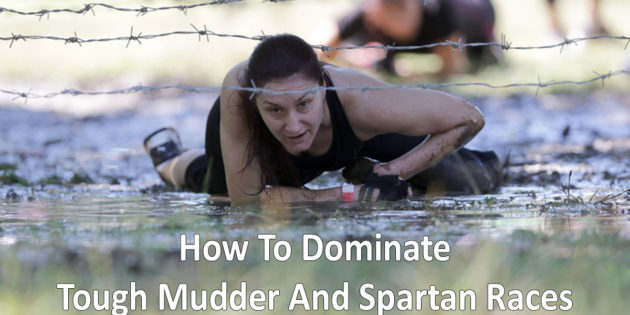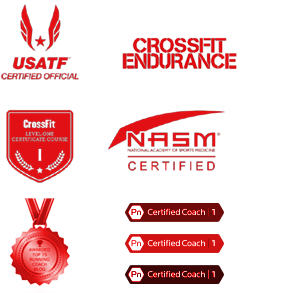Obstacle Course Racing (OCR) like Tough Mudder and Spartan Races are still so new that many people have no idea how to train for them. They throw mud at the wall (literally!) to see what sticks.
Among their more or less random ideas:
- Picking up the heaviest thing they can find on a run
- Wearing weight vest for every activity
- Going rock climbing and playground training
- Doing CrossFit and weight training
- Getting out to run on trails and hills
- Races, Races, Races
Take my friend Brad. He’s caught the OCR bug big time and has become a bit of a junkie. Our conversations usually go something like this.
“What do you have going on? What’s new?”
“I have a Spartan Beast next week, a Terrain Race in two weeks, and near the end of the month, I am doing a Toughest Mudder. Then next month I have two in the first few weeks.”
“Wow, man. That seem’s like a lot. How are you holding up?”
“Well, My ankles are pretty much swollen week, and I have some lower back pain when I start to run. So, I keep it low key until the weekend. But I freakin love it!”
“So, what are you doing to train for these races?”
“You know, I run a bit, I’ll throw on a weight vest and hike, and I try to get to CrossFit once or twice a week.”
“Got ya! So, what’s the deal with the races? What do you want to get out of them?”
“I think I can be competitive! I want to qualify for Worlds.”
While Brad is pretty advanced, and his dedication is commendable, he is still making the same mistakes as newbies:
- No base work
- Ignoring weaknesses
- Racing too often
Brad just wants to race and doesn’t quite understand how to help himself improve as an OCR athlete. His training is intense but lacks direction.
Don’t be like Brad. Train smarter to get better results. Here’s how:
Stop Trying To Do Everything at Once
Many OCR athletes try to do everything at the same time and end up accomplishing very little. They want to get better at carries while getting better at running while getting better at their obstacle skills.
But they only have an hour at a time to train a few times a week. So they try to throw everything into the mix every training day. The logic seems to be “if I can simulate the race during training, I’ll improve for race day.”
It’s a seductive line of thought. But it’s mistaken.
You first need the baseline fitness required for each task. Only then can you work on improvements. For example, to become a faster runner, you need to practice running fast. Running with a weight vest or with a log will literally weigh you down. You will not be able to run as fast as you need to create a response for your body to adapt.
The same goes for your carries. If you want to get better at a bucket or log carry, you need to create an overload to become stronger. The bucket or log itself is not heavy enough for your body to need to build muscle.
Still puzzled? Think of another sport. Let’s take basketball. If you wanted to get better at shooting free throws, you wouldn’t only practice shooting three-pointers. Doing so may help you become a better shooter, but it will not help you get to your ultimate goal of being a better shooter from the line.
The same principle applies for OCR training. Carrying a sandbag up a hill may help you in the short term, but there are bigger gains you can make with a smart running and strength plan.
Which is what I call….
The OCR Training Pyramid
To fully maximize your ability to become a better athlete you must improve following areas.
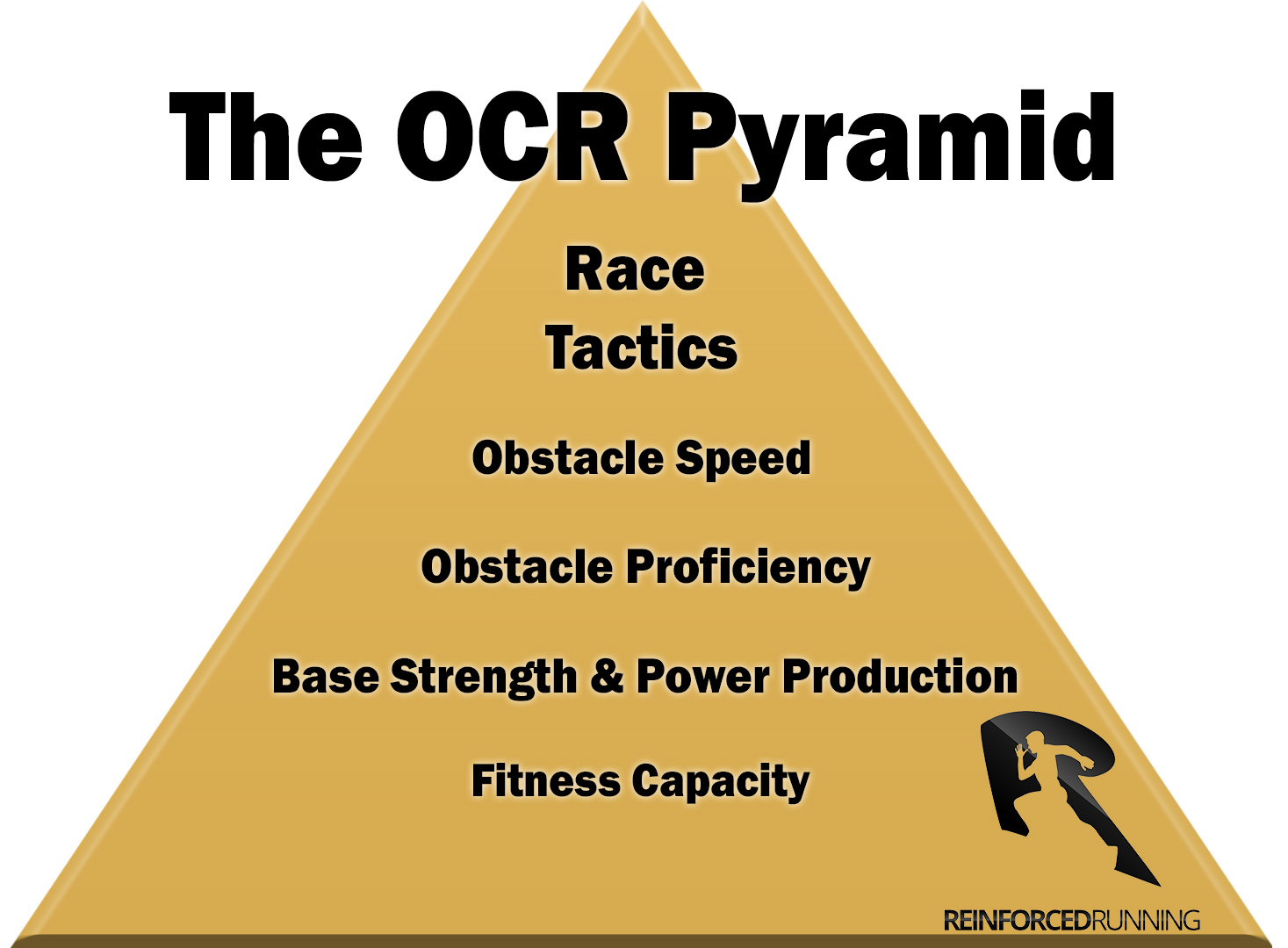
Why Fitness Capacity Matters
Your fitness capacity is how fit you are relative to your past self and the competition. The best athletes in OCR are the best runners and those who have the highest work rate.
Contrary to what many people think, being the strongest or fastest person at the starting line is not themost the most important piece to success. What you need is to be able to work at a high rate for a long duration
After all, even a short OCR course will take 45-60 minutes to complete.
The best and easiest way to improve your work capacity is to become a better runner. You spend most of the time in between the obstacles. This time is what separates the competitive field from the rest.
How to Improve Your Running
It’s all about planning and progression.
To become a better runner, you need to have a plan to improve. Many athletes run with a running group or friends. They just put on their shoes and head out the door without any real idea of how the workout at hand will help them in the short and long term.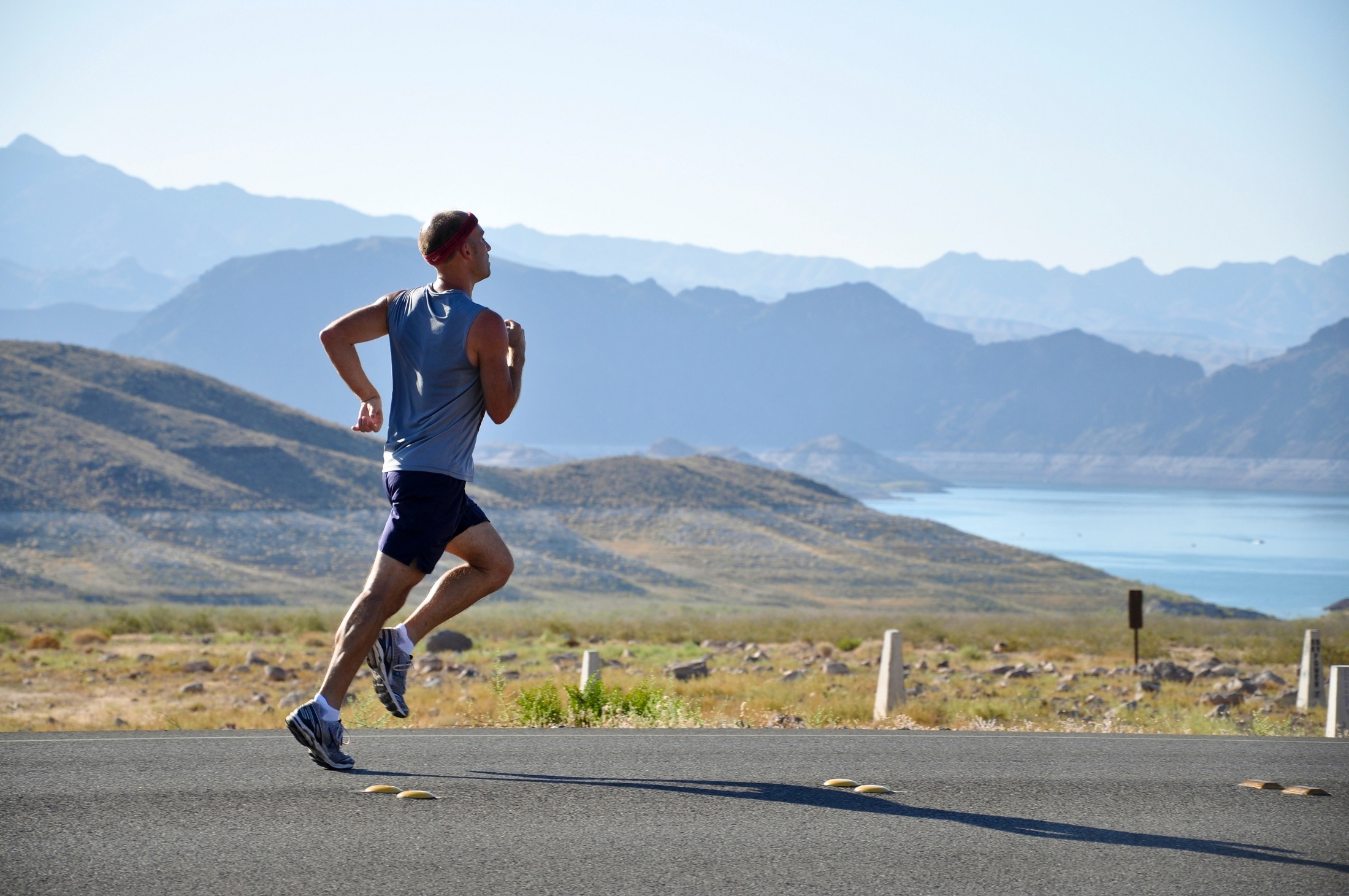
Create a plan for improvement and have set benchmarks to check in on your fitness. These check-ins will then act as a catalyst to change your training stimulus. Work in 3-4 week phases before you check in.
This is where a good coach can be helpful.
Training Phase Example
Weeks 1-4: Base
- Easy miles
- Progression runs
- Building volume
- Learning pace
Weeks 5-8: Speed Endurance
- Interval-based workouts
- Increased intensity
- Building volume
- Improving sustained pace
Weeks: 9-12: Race Specific
- Race Specific workouts
- Running on race terrain
- Simulating race factors
- Create a race plan.
The progression of each of these phases creates long-term fitness growth you are trying to achieve.
I know it is more fun to swing on monkey bars and your social media post look better when you are carrying a log, but to improve your running fitness you have to run. Sorry for the tough love, but you need to know the truth and start putting in the work.
Base Strength and Power Production Lead to Obstacle Domination
Every obstacle in a race requires a requisite amount of strength, mobility, and coordination.
But many OCR athletes try to run before they can crawl. They spend a lot of time trying to improve their ability to complete the obstacle. Instead, they should be building the pieces that make it easier for them to improve.
For example, if you consistently fail the rig or monkey bars, it is likely that you do not have the upper body or grip strength to make it happen. Instead of spending your time attempting and failing the rig, you should devise a plan to improve the required grip and upper body strength.
You need to build a foundation before you build a house. In this case, the house is completing the obstacles, and your foundation needs to be your strength.
The answer is not in a new technique or a pair of gloves that you bought on spartan.com.
It is getting your butt to the gym in the gym and getting the work done.
Building Your OCR Obstacle Foundation
Success comes down to four things:
- Grip
- Pulling
- Compound Moves
- Mobility
Grip
How many times have you been literally left hanging at an obstacle because your grip is toast? Poor grip strength can leave you vulnerable during the race and will cost you a TON of time. Add these exercises to your workout routine independently from obstacle specific training.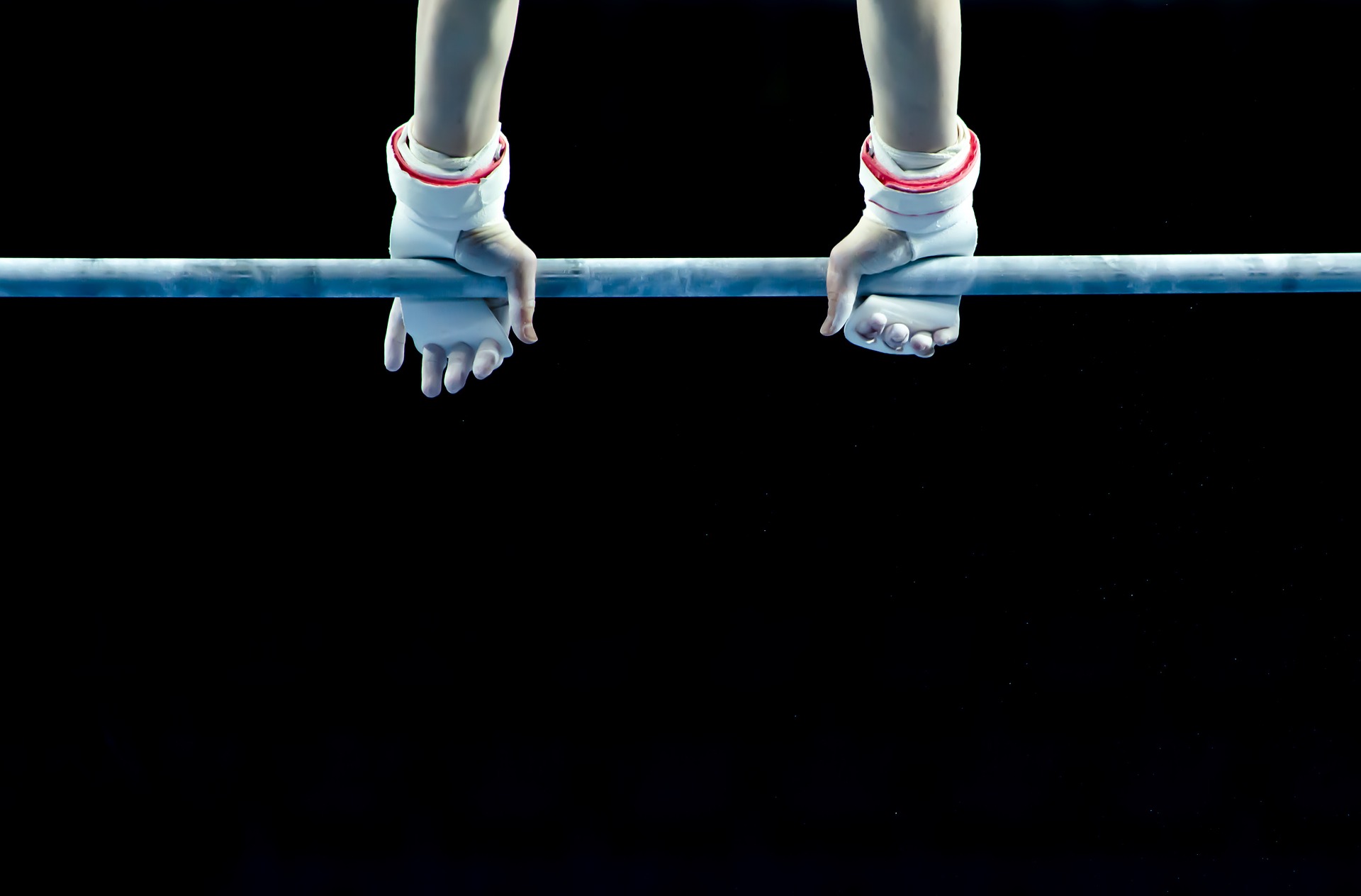
Key Exercises
- Dead Hang
- Hand Switch
- Towel Hang
- Dumbbell Curls
- Plate Pinch
- Farmers Carry
- Bouldering/Rock Climbing
Progress the exercises by adding time and reps each week. This will help your body build and adapt and will show you the progress that you are achieving.
Grip Workout EX)
4 x Max Dead Hang – 30 sec rest
6 x 10 sec plate pinch
2 x 40 second Farmers Carry (heavy)
Pulling and Back
In every race, there is a time where you are asked to either pull yourself up and over obstacles or to pull an object from one point to another. Building strength in your back and lats will help you clear a wall, dominate a hoist and complete a rig.
Key exercises
- Pull up
- Ring Rows
- Pull Up/Ring Row Hold
- Rear Delt Flys
- Face Pull
- Band Pull Apart
Take three to four of these exercises and place them in your routine two times a week.
Pull Workout Example:
5×5 Pull-ups
3×8 Super Set
Face Pull
Band Pull Apart
3xMax Pull up/Ring Row Hold
Compound Movements
Hip hinge exercises are typically your hip hinge movements like the deadlift and squat. These movements will help you build the most strength and muscle of all exercises. These drills will help you carries, heavy lifts and power hiking/hill running.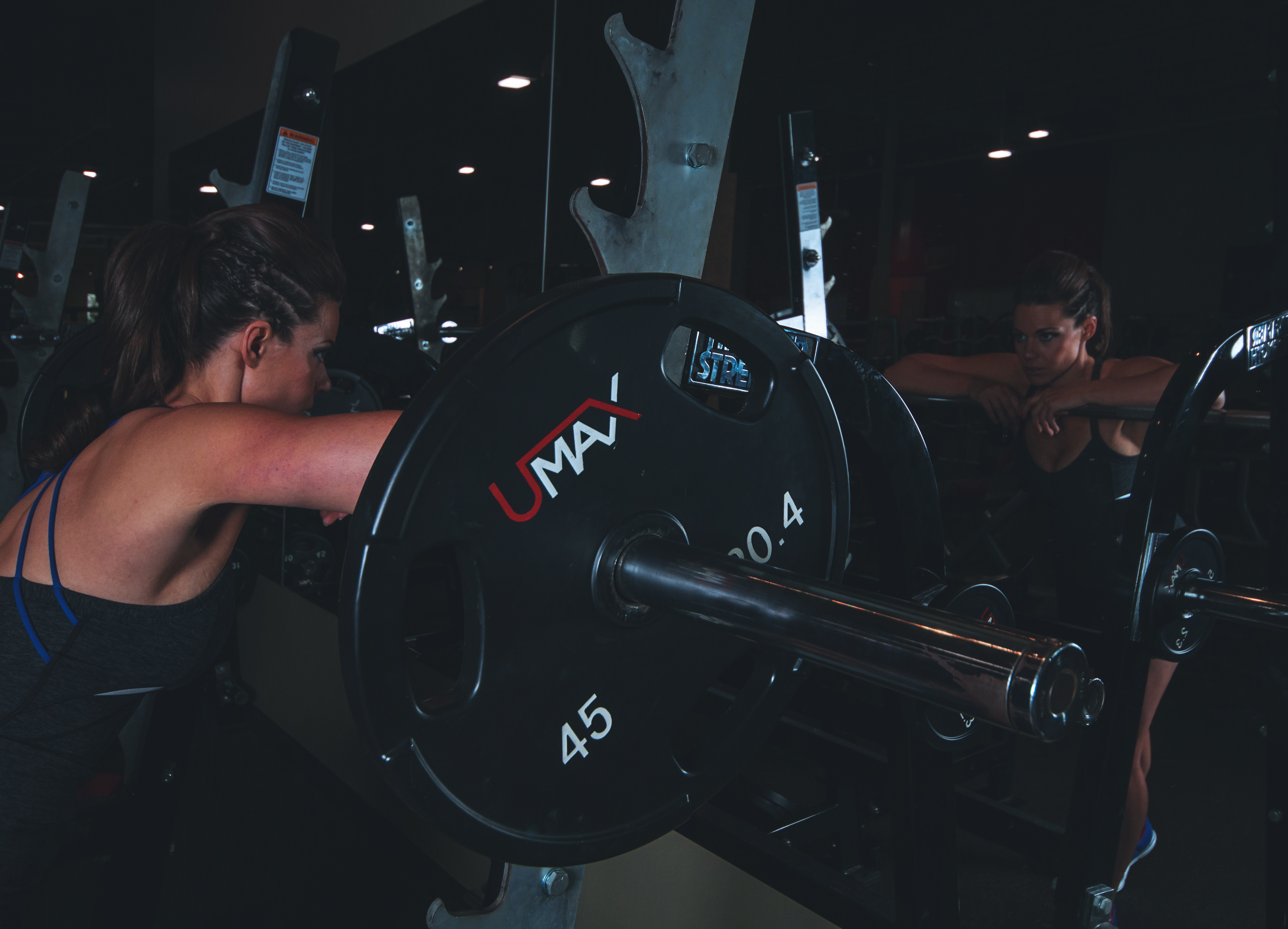
Key Exercises
- Deadlift
- Squats
- Bent Row
- Sand Bag Carry
- Tire Flip
You get a great bang for your buck during these exercises, but they need to be done HEAVY!
Do one or two of these exercises twice a week.
EX)
Day 1)
Deadlift 5×3
Bent Row 5×5
Day 2)
Back Squat 6×3
Sand Bag Carry 2 x 40 sec – HEAVY
Mobility
Your mobility is more important than you realize. The best athletes can attack the obstacles without restraint. If you have tight hips or your knees and struggle to bend down and stand up, you will lose time. Working on your mobility only takes about 10 minutes a day and can be the missing piece to your training.
You will be floored after you work on your mobility as you will feel better in your day to day and eager to attack mud and crawling obstacles pain-free.
Now that you have spent time building your strength base you are ready to take on the obstacles.
How To Create A Strategy
One of the most fun pieces of OCR is there is no single way to do the obstacles. You are good to go as long as long as you get through them. You need to figure out what strategy to get you through the obstacles penalty free.
Play to your strengths. If your single arm hanging strength needs improvement, don’t use a Tarzan swing on the monkey bars. Grab each rung with both hands before moving to the next.
Simulate the race conditions, It is easy and fun to go through an obstacle when you are fresh and breathing easy. However, the point of training is to make race day easier. You need to be able to simulate what the obstacle will feel like on race day. Chances are that when you come up to obstacles that you will not be breathing easy with dry hands. Create a scenario in training where you are sweating and out of breath!
Sample Workout
3 rounds of:
20 burpees
Monkey Bars or hand switches
– 30 sec rest
The options are limitless when it comes simulating a race. Be creative and use what you have. Run first and go directly to an obstacle, or your do obstacles back to back.
Obstacles Speed
Now you have a strategy to beat the obstacles. You can now work on your speed to get through them as quickly as possible. There is nothing more frustrating than running someone down, and to lose the gained time after an obstacle. To improve your speed on obstacles you need to practice doing them fast!
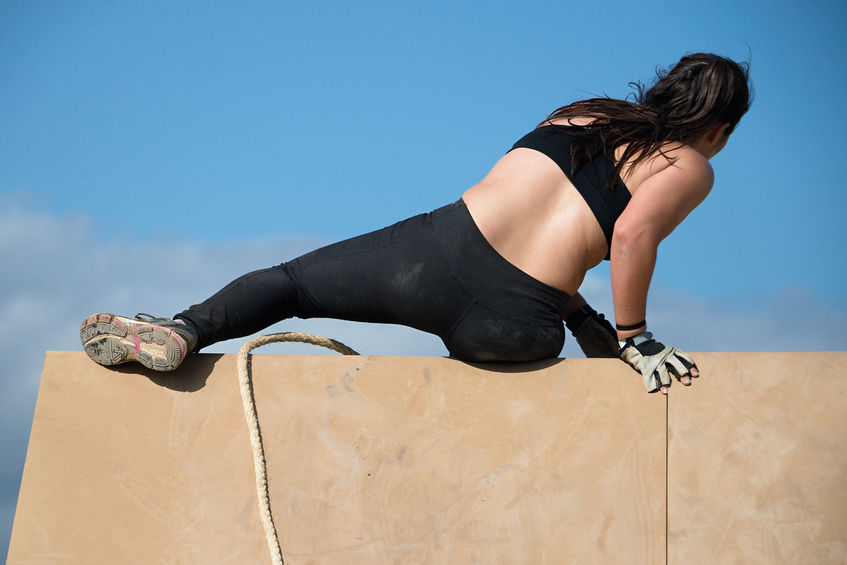
Short Burst of Exercises
Do workouts that are brief but aggressive. Go through a rig or a carry as quickly as possible for a short duration. Sprint up a hill with a log, bear crawl 50 meters all out. Build on your progress by adding time or speed. Take sufficient time to rest between each set so that you feel fresh and ready to hit another set with speed.
Speed Workout Example
10 x 30 secs Bucket Carry Sprint
– 45-second rest.
Timed Benchmark Workouts
Make an obstacle benchmark so that you can test your fitness and push yourself against a standard you have set. Check in with your obstacles fitness and speed every three to four weeks
Bench Market Workout Example
3 Rounds for time
400 m run
Monkey Bars
200 m Carry
Race Tactics
Now that you have practiced all the pieces that will make you an effective OCR athlete you can dial in your race day tactics. These are the things that will ensure you have a good race, but will not make up for lack of preparation. Your race tactics include things like the best route to take or hacks that will help your carries and climbs.
A good example of a tactic would be when you grab the bucket carry, and you use a wristband to lock your hands around the bucket. This strategy will help you engage in the appropriate muscles to make the carry easier, but you must first have the requisite muscle strength to get there.
Race nutrition can also fall under tactics. All too often I hear people complain about cramping and trying to find a solution. The solution is in training, not a number of electrolytes that you drink during or before the race.
Tactics are meant to help you squeeze every bit of performance out of the OCR machine you have built, not to skip steps along the way.
Putting It All Together
The hardest part of training is sticking to a plan. The best way to put your performance together is by making a program and working hard. Many OCR athlete have terrible cases of training ADD. With every new obstacle or race, the OCR athlete is ready to change the direction of their training.
There are no shortcuts, but it’s hard to know if you are doing the right things. To stay on the correct course, you need to create some accountability to make it happen. Make a plan and share it with friends, or grab a coach/mentor to help you make a plan.
If you are ready to take action and become a better OCR athlete, I can help you take the steps and keep you on the desired path. I would love to chat with you and create a plan that will get you to the next level.
